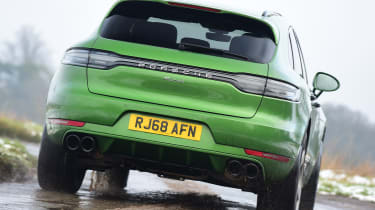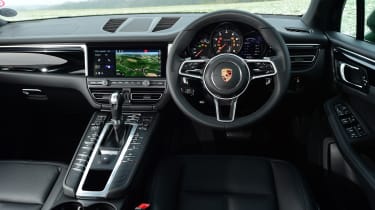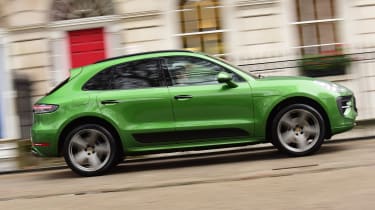New Porsche Macan 2019 review
Diesel’s out and petrol’s in for the new entry-level Porsche Macan SUV, but is it an improvement? We find out..
The Porsche Macan is still one of the sweetest premium SUVs to drive. The entry-level 2.0-litre petrol engine doesn’t tingle with presence, but its strong reserves of torque mean you won’t miss the V6 diesel all too much. Throw in scorching dynamics, plus a variety of welcome tech upgrades, and it’s clear that the Macan has solidified its position towards the front of the pack.
There’s little avoiding the fact that the Porsche Macan SUV has become a common sight on UK roads. Globally, almost 100,000 models found homes in 2017. That year, one in four new Porsches had a Macan badge, in fact; four times as many cars as the maker sold with the 911 nameplate.
To keep that momentum going, the Macan has just been given a facelift. As ever, some subtle design changes separate old from new: there’s now a full-width LED tail-light bar at the back, new headlights and slightly different air vents. Inside you’ll find a new 11-inch touchscreen display.
However, the big news with this latest Macan is the removal of the huge-selling V6 diesel engine. It follows the ditching of all such units in the Cayenne and Panamera ranges, and as such, Porsche now doesn’t offer a single diesel across its entire line-up.
That means most buyers are expected to flock to the new entry-level model. It uses the 2.0-litre four-cylinder turbocharged engine that you’ll find in the likes of the Volkswagen Golf GTI and the Audi TT. Power stands at 242bhp, with 370Nm of torque sent to an all-wheel-drive system through Porsche’s seven-speed PDK gearbox.
More reviews
Car group tests
- Maserati Grecale vs Porsche Macan: 2023 twin test review
- Porsche Macan T vs BMW M135i: 2023 twin test review
In-depth reviews
Road tests
That torque figure is important. With no diesel Macan, the petrol has to pick up the pieces – and thankfully, it bridges the gap rather neatly. Of course, the level of grunt is more modest, but it certainly isn’t lacking.
Porsche has re-worked the 2.0-litre engine to deliver as much of its punch as low down the rev range as possible. As ever, the excellent all-wheel-drive system works impeccably when it comes to placing the power on the tarmac – even in wet and snowy conditions like we tested it in.
The 2.0-litre petrol engine doesn’t offer a spine-tingling edge, but it is capable of thrusting the 1,800kg Macan up to speed at a confident rate. Those after a bit more punch should look to the 3.0 V6 Macan S, which with 349bhp can do 0-62mph in 5.3 seconds. There is no harder, faster GTS or Turbo versions for the time being, although both are expected later down the line.
The standard Macan we’re driving here can also return a claimed 35mpg, which isn’t bad at all. But high CO2 emissions of 185g/km place it in the top company car tax band, making it a pricey option for business users after a sporting SUV.
There was very little wrong with the way the Macan drove pre-facelift – in fact, it’s been the best-driving SUV on the market since its launch. However, Porsche has gone in search of even more ability and dynamic agility with some suspension revisions, including new, lighter and stiffer springs.
Although the changes are intended to unlock more agility, they haven’t spoiled the latest Macan’s ride. It’s firmer than a Range Rover Velar over rough roads, but it’s still surprisingly pliant.
Keener drivers should probably opt for Porsche’s Active Suspension Management pack. Set the damping to Sport Plus and stick the engine in Sport mode, and the car’s transformation is tangible. The steering is still sweet and so well weighted, and the sportier new steering wheel, which is lifted from the 911, is a very nice touch indeed.
The Macan still nails its brief as an SUV that you won’t tire of driving, but it’s also a modern-feeling car inside – even five years into its life. The larger, upgraded 11-inch display mounted flush in the middle of the dashboard keeps the interior feeling fresh, and it’s far slicker to use than the item it replaces.
Standard kit is pretty good, with every version now featuring online navigation and Apple CarPlay (Android Auto isn’t even an option), plus three USB ports, a 10-speaker stereo and a DAB radio. The Comfort Seats offer eight-way electrical adjustment, while our car featured the £1,094 optional Black Leather Package.
Externally, all cars get that fantastic new light bar and 18-inch wheels. Our Macan’s 21-inch rims were a £3,363 option, and the Mamba Green paint is extra as well.
The 500-litre boot is large enough to deal with family life, but the Macan is still one of tighter cars in its class when it comes to practicality and cabin space.
Headroom in the back is pared back ever so slightly by the SUV’s shape, while legroom in the rear will be at a premium for adults if those up front need to position their seats right back.
A Jaguar F-Pace beats the Porsche here, while a Range Rover Velar offers far more cargo space thanks to its 673-litre boot. Of course, both those cars are available with diesel powertrains, too, and will generally be more comfortable day to day. However, if these are trade-offs you can live with, the Macan remains one of the finest SUVs you can buy today.







